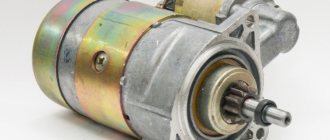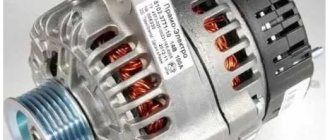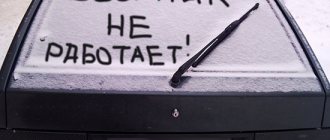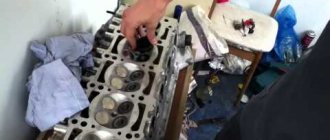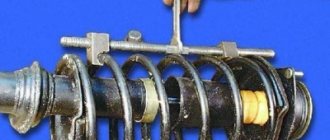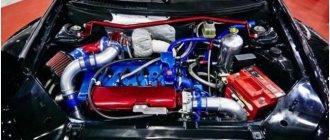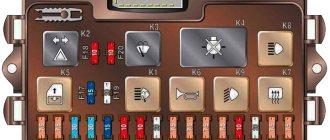Repair of generator VAZ-2108 (2109-21099)
A car is like a living organism - all its parts require careful care and handling. But, like the human body, the machine sometimes malfunctions.
The failure of an electric generator can cause a lot of problems for the car owner, but there is nothing difficult in repairing it, and even more so, there is nothing that a man cannot handle.
So, today we will repair the electric generator.
The generator in the car is used to generate electrical energy and supplies power to the battery. If the normal operation of a car electric generator is disrupted, the battery begins to discharge, and the car will drive only as long as the battery charge is enough.
The electric generator is located under the hood of the car and is driven by a belt drive. The cause of generator breakdowns is the following malfunctions : exhaustion of the generator brushes, malfunction of the charging relay, failure of the generator diode bridge, jamming of the generator rotor shaft bearings.
Checking the VAZ 2108-21099 generator to identify faults:
- The presence of extraneous noise during operation means probable wear of the generator shaft bearings.
- Insufficient voltage at the “output” of the generator – wear of the brushes or insufficient belt tension.
- An increase and decrease in the voltage at the “output” can also be a consequence of a malfunction of the generator diode bridge.
For initial diagnostics of faults, it is enough to perform the following procedures:
- Check the voltage at the battery terminals with a voltmeter. With the engine running and the generator working, the battery voltage should vary from 13.8 to 14.5 volts.
- With the engine running, place your palm against the generator housing and detect vibration. With increased wear of the shaft bearings, the vibration transmitted to the generator housing will be more than noticeable, and it will be very difficult to confuse it with anything.
- Checking the tension of the generator belt: with the engine turned off, you need to press on the belt - its deflection under your finger should not be more than 1 - 1.5 cm.
Charging check
Diagnosis is carried out using various methods. The main ones are: visual inspection, computer diagnostics and testing using physical measurements.
A caring owner must carry out a visual inspection of the gene and battery at least once every 7 days.
In addition, in the summer it is necessary to monitor the battery electrolyte stages. This is done through the provided battery window or through the light.
The electrolyte can boil out of the battery not only due to extreme heat, but also due to overcharging. That is, the gene can be faulty and produce more current than necessary. Obviously, the result of such a situation will not lead to anything good - the acid concentration will increase, the plates will corrode, and the current will increase even more.
It is not difficult to determine the boiling off of the electrolyte from a faulty gene. Such a process will a priori lead to the destruction of the battery. Alien plaque, transformation of the paint layer, etc. will be noticeable on the battery case. On batteries with a control window, the indicator will glow red rather than green.
The practical part is removing the generator, disassembling it, repairing it and reinstalling it.
Due to the fact that the generator is located under the hood of the car, it is necessary to turn off the engine, turn the steering wheel to the right all the way and open the hood. The electric generator on VAZ 2108 - 15 cars is installed in front of the engine, in the lower left corner of the engine compartment, between the engine and the cooling radiator.
Before dismantling the generator, it is necessary to disconnect the ground from the battery, i.e. negative contact.
Replacing VAZ generator brushes
Before removing the generator itself, in order not to do unnecessary work, we remove the charging relay from the generator housing and check the production of the generator brushes.
The charging relay is installed in the rear of the generator housing, and is attached to it with two bolts. To unscrew them you will need a Phillips screwdriver. When unscrewing the bolts, be careful not to drop them on the crankcase guard, otherwise getting them out of there will be one big problem. To remove the relay, you need to disconnect the wire, the “female” contact. After removing the charging relay and visually inspecting the brushes, we decide to purchase a new generator voltage regulator relay or reinstall the dismantled one, depending on the wear of the brushes. For their normal operation, a brush length of at least 4 cm is required. Now we proceed directly to removing the electric generator from the engine.
- We disconnect the wires from the generator - as a rule, they are red and consist of two groups of wires, red. One group consists of two wires and is attached with a nut to a bolt on the rear wall of the generator. The other group consists of one wire and is connected to the generator terminal via a male-female contact, also on the rear wall of the generator.
- To remove the generator from the engine, you need to unscrew two nuts and one bolt in the following sequence: unscrew the nut attached to the generator belt tensioner bar (at the top of the generator), unscrew the bolt securing the tensioner bar to the engine block and remove it. The last step is to unscrew the nut from the bolt securing the generator bracket to the engine block.
- The generator mounting bracket is located at the bottom of the engine block, directly below the generator. After unscrewing this nut, you need to remove the generator belt from the generator pulley itself.
- The generator mounting bolt should be pushed to the left, out of the bracket, until it stops against the body shell or the generator’s mud protection.
- On the right wheel side, you need to unscrew the two screws that secure the dust protection of the generator to the car body.
- If the generator mounting bolt still rests against any body parts, you should press on the engine with one hand, and at the same time pull out the bolt with the other hand.
Now your generator is completely disconnected from the engine, and you can begin to disassemble and repair it.
Disassembling the electric generator
When disassembling an electric generator, you need to have two important things on hand: a bearing puller and a vice. This will greatly simplify and speed up your work. Using a wrench set to “19”, unscrew the nut from the rotor shaft, which secures the impeller to the shaft.
To do this, you need to hold the impeller directly with one hand and unscrew the nut with the other hand, counterclockwise. It will take some effort, of course, but this nut needs to be unscrewed. The generator impeller is secured to the shaft with a key, and after removing the impeller from the shaft, it is necessary to remove this very key.
Now we turn the generator over with the back cover up, and unscrew the four nuts with an “8” wrench. We take out the released four studs and release the front part of the generator housing.
In the front part of the generator cover there is a “front” bearing secured by plates. We remove it by unscrewing the nuts and plates and knock the bearing out of its seat. The easiest way to do this is with a wooden plank, the size of which matches the diameter of the bearing.
Now we need a vice: screw a nut onto the rotor shaft and secure the generator, or something that we have not yet disassembled, in the vice. We tear off the back cover with a sharp upward movement from the bearing seat.
We still have the rotor shaft clamped in a vice, with the “rear” bearing in the very top part. To dismantle it, you need a puller; we put it on the bearing and remove it from the shaft.
Now you have two bearings on your hands - “front” (small) and “rear” (larger) - look at their markings and purchase exactly the same ones.
Important : Practice shows that when purchasing bearings for a generator , you need to remove them and, by analogy, buy them in a store. Advice from sellers such as: “they are all the same type” or “if you have an old-style generator, then take these” are often wrong. Yes, they are almost always wrong. To save time, the easiest way is to remove the bearings and select similar ones based on their markings.
The same advice applies to the diode bridge installed in the rear cover of the generator. If damage or metal oxide is visually observed on it, it is better to remove it without hesitation (it is secured with four nuts to the inside of the back cover) and purchase a new one.
Cost of spare parts (on average): Bearings (pair) – 150 rubles. Charging relay: 140 rubles. Diode bridge – 200 rubles. Bearing puller - 100 rubles. Total: 590 rubles.
The generator is assembled in the reverse order:
- We start by installing the rear bearing on the shaft. This is done using a hammer and a small board. With two or three blows we seat the bearing on the shaft.
- If the diode bridge is removed, we fix it in its “original” places, on the same four studs, in the back cover of the generator housing.
- We install the back cover on the generator rotor so that the bearing completely “sits” into its seat in the back cover of the generator; to simplify the procedure, you can use a hammer and, with not very strong blows on the back cover, “seat” it onto the shaft.
- In the front cover we replace the small (or front) bearing and secure it with plates in the seat.
- We take the generator out of the vice and before putting on the front cover, we put the spacer ring on the shaft, between the front bearing and the thrust recess on the shaft.
- We install the front cover and tighten the nuts “crosswise” on long studs so that the tightening is even.
- We install a key in the recess on the rotor shaft, then put on the generator impeller and tighten it with a nut.
Complete disassembly of generator 37.3701
Let's analyze the 37.3701 generator removed from the engine, taking into account some of the features of its disassembly. This generator is installed on VAZ 2108, 2109, 21099 cars of early years of production. But it is completely interchangeable with the later generator 9402.3701 and similar ones. Its disassembly is not particularly difficult and requires a minimum of tools and a minimum of skills in repairing such devices.
Required Tools
— Phillips and slotted screwdrivers
— Socket wrenches (heads, socket wrenches) 8 mm, 10 mm, 19 mm
Disassembly procedure for generator 37.3701
— Remove the voltage regulator
On the 37.3701 generator it is combined into a single unit with brushes (although until 1996 these were two different parts). First, disconnect the tip of the diode bridge wire from the voltage regulator. To remove the regulator, unscrew the two screws securing it with a screwdriver and remove it from the hole in the rear part (cover) of the generator.
Removing the generator voltage regulator 37.3701
— Remove the generator pulley
To do this, we stop it from turning with a screwdriver and unscrew the nut securing it with a 19 mm spanner. The tightening torque is large, so it is better to use a wrench with a long handle.
Removing generator pulley 37.3701 for VAZ 2108, 2109, 21099 cars
Then we remove the following parts: nut, washer, pulley with impeller, segment key.
Removing the generator pulley
— Remove the capacitor
To do this, use a 10 mm wrench to unscrew the nut securing its wire from terminal “30” of the generator. Using a Phillips screwdriver, unscrew the screw securing the capacitor to the rear half of the generator and remove it.
Removing the capacitor from the generator
— Separate the halves of the generator housing
First, we mark their relative positions (by placing marks on both parts). Using a 10 mm wrench (it’s more convenient to use a socket or socket wrench), unscrew the four nuts of the coupling bolts (there are engraving washers under the nuts).
Unscrewing the nuts of the generator coupling bolts
Pull out the bolts. Remove the front part of the generator. Remove the rotor from the back of the generator. If it cannot be removed, you can tap it with a soft metal drift through the window under the voltage regulator, or by screwing a nut onto the thread of the shaft and holding it in a vice, with a sharp upward movement, pull the back cover into the shaft. The bearing remains on the rotor shaft. If necessary, we dismantle it with a puller and press on a new one (See “Replacing generator bearings”).
We disconnect the parts of the generator housing
— Remove the bearing from the front of the generator
We carry out this operation if it is necessary to replace the front bearing of the generator. Using an 8 mm wrench, unscrew the four nuts securing the front bearing protection plate. Let's take it off.
Removing the front bearing of the generator
With a light blow of a hammer on the end of the rotor shaft, we knock it out together with the front bearing from the front cover of the generator. Remove the rear protective plate with screws and spacer ring from the shaft.
Removing the generator rotor
In another case, you can more carefully use a piece of pipe of a suitable diameter to knock out the old bearing along with the shaft. We pry the bearing from different sides with a mounting tool and move it from the rotor shaft with sharp movements (you can use a puller).
— Disconnect the stator
Using an 8 mm wrench (it’s more convenient to use a socket or socket wrench), unscrew the three nuts securing the stator terminals to the diode bridge. We remove it from the back cover of the generator by prying it with a slotted screwdriver or hitting it with a hammer.
Do-it-yourself generator disassembly and repair
It may seem wild to some, but very often you come across owners of VAZ 2109-2108 who, at the first malfunction of the generator, prefer not to repair it, but simply replace the device with a new one. There are even those who don’t bother to check the wear of the brushes, but immediately run for a new generator. In fact, you can perform a repair, that is, replace a obviously faulty part with a new one and that’s it, the device will work for another hundred years!
In order to disassemble the generator on a VAZ 2109-2108, we will need the following tool:
- open-end or socket wrench 17
- 10 and 7 mm head
- ratchet handle
- Phillips and flat screwdriver
The procedure for disassembling and replacing generator parts on a VAZ 2109-2108
So, the first step is to disconnect the wiring from the integral with brushes and unscrew the two fastening bolts, which are shown in the photo:
Then the brushes are removed without any problems, since nothing else holds them. After this, you need to try to unscrew the pulley nut, while keeping the pulley itself from turning. Since it is not easy to block it with improvised means, you can first unscrew all the nuts securing the back cover, as shown in the photo below:
After this, the bolts become free and therefore can be slightly squeezed out in the opposite direction. This is necessary so that they block the pulley, as they will get between the blades. This can be seen more clearly in the picture below:
Now the nut can be unscrewed without any problems, and after that you can remove it, and the pulley accordingly:
Then remove the 4 bolts that connect the two parts of the generator:
Then, using a wide flat screwdriver, we try to separate the component parts of the device, this is clearly shown in the photo:
But it is also worth removing the key, as it will not allow you to remove the cover:
Now you can remove the cover:
It can be removed either separately or immediately together with the rotor. Although, the rotor can be removed later without difficulty:
Next, we just have to disconnect the winding (generator stator) from the diode bridge (rectifier unit). To do this, use a socket to unscrew the three nuts securing the winding contacts to the diode bridge:
After which you can remove the winding without any problems:
To remove the diode bridge, you need to remove the bolts that secure it from the back of the back cover, as is clearly demonstrated in the photo below:
It turns out that the entire VAZ 2109-2108 generator is completely disassembled into its component parts, each of which can be replaced if it fails. Read more detailed material on diagnosing generator parts in the following articles in this section. Assembly occurs in reverse order.
Source
Malfunctions, repair and replacement of the VAZ 2108 generator step by step instructions
The VAZ 2108 device, like any other vehicle, involves powering electrical circuits from a battery. To ensure that the battery is always in good condition and does not let you down at the most inopportune moment, a generator is always connected to it.
The battery is especially important when the engine is ignited; while driving, when the car develops sufficient speed, the entire electrical circuit is powered by the generator.
When the question arises about connecting additional powerful electrical appliances to the car, it is very important to match their load with the permissible power of the generator. To do this, it is important to know its technical characteristics. And if the battery lack of charge indicator suddenly lights up, it’s better not to even look under the hood without understanding how the electrical charging circuit, voltage regulator and ignition work.
After reading today's article to the end, you will learn about the connection diagram and dimensions of the VAZ 2108 generator, the main reasons for failure and how to check the voltage in the circuit. If trouble happens to the generator, then don’t worry, we will clearly show you the process of removing and installing it.
Why is a generator needed?
It is needed to power the on-board network when the engine is running. When stopped, the entire network is powered by a battery. If you yourself replaced the VAZ-2108 generator or any other car, you saw that it has one power terminal. Several wires are connected to it:
The thickest one connects the generator to the positive terminal of the battery. It is through this wire that the battery is charged.
Please note that there are no fuses on it. Therefore, during any manipulations with the generator, it is necessary to de-energize the on-board network. A thin short wire going to the voltage regulator is necessary to power the excitation winding. It is rare, but it happens that additional equipment is connected to this output of the generator.
The cars use a rather old but proven design of the VAZ-2108 generator. The carburetor is used in the fuel injection system. On injection cars, fuel injectors and ignition coils are powered from the power output of the generator. All other consumers take power from the positive terminal of the battery.
VAZ 2108 generator circuit
The VAZ-2108 generator has a rather massive stator winding, since it uses a large cross-section wire. It is with its help that electricity is generated. The wire is wound evenly over the entire inner surface of the stator into recesses specially provided for this purpose in the magnetic core.
It’s worth talking about the latter separately. The middle part, the generator stator, consists of a series of thin metal plates pressed tightly together. They are often boiled on the outside to prevent separation.
- Alternator. The 37.3701 or 94.3701 series can be installed.
- Negative diode.
- Additional diode.
- Positive diode.
- Alternator warning lamp, also known as battery discharge lamp.
- Instrument cluster.
- Voltmeter.
- Relay and fuse box located in the engine compartment in the compartment between the engine and the vehicle interior.
- Additional resistors built into the fuse mounting block.
- Ignition relay.
- Egnition lock.
- Accumulator battery.
- Capacitor.
- Rotor winding.
- The voltage relay is located in the engine compartment.
Generator 2109: device and features
Let's start with the fact that alternating current generators are installed on the VAZ 2109: series -37.3701 (design using a V-belt drive) and series - 94.3701 (design using a poly-V-belt drive).
Let's take a closer look at the connection diagrams, methods of diagnosing and repairing the generator device on the VAZ 2109 (design features of automobile generators: series 37.3701 and 94.3701).
The design of the generator series 37.3701 consists of more than 20 elements:
- bushing, clamping and buffer fittings;
- back cover of the unit, bolt fixing the rectifier device, rectifier unit with valve;
- capacitor component;
- pulley and rear bearing of the rotor shaft;
- impeller, shaft, brush connected to the output on the control mechanism, thrust ring;
- contacts for connecting electricity consumers;
- stator mechanism, rotor winding, etc.
Technical characteristics of the VAZ 2108 generator
The following generator models are installed on VAZ 2108 cars:
Technical characteristics of the first:
- The value of the delivered current (at 6000 rpm-1 and a voltage of 13 V) – 55 A — The voltage value – 13.6 – 14.6 V
- Rotor rotation direction – right – Maximum rotor speed – 13000 rpm-1
- Engine/generator gear ratio 1/2.04
Technical characteristics of the second:
- The value of the delivered current (at 6000 rpm-1 and a voltage of 13 V) – 80 A — The voltage value – 13.2 – 14.7 V
- Rotor rotation direction: right
A normally working, serviceable generator of VAZ 2108, 2109, 21099 cars and their modifications produces a voltage in the range of 13.6 V - 14.6 V. This can be visually tracked using a voltmeter on the instrument panel, but it is better to measure the voltage with a voltmeter (multimeter, autotester
Reasons for failure of the VAZ 2108 generator
Experts believe that the main reasons for the failure of the VAZ 2108 generator are:
- voltage regulator failure;
- damage to the diode bridge (aka rectifier);
- wear of current collecting brushes;
- defects in the charging circuit wires;
- damage or operational wear of the pulley;
- wear of slip rings or commutator;
- short circuit of individual turns on the stator winding;
- bearing failure.
Every self-respecting car enthusiast should understand what causes generator malfunctions most often and how they can be dealt with. It is also necessary not to forget that timely prevention helps to avoid serious problems. Towards the end of the article, we will look at some tips that will help you learn how to test the generator yourself. But let's first learn about the internal structure of the node.
Possible faults
Since any generator for an 8- or 16-valve injector engine is an electromechanical mechanism, there can be several types of malfunctions. These could be mechanical or electrical failures.
- Mechanical failures include failures associated with the destruction of pulleys, bolts or mounting brackets, excitation brushes, commutator, rings, rotor, bearing devices or the housing as a whole. Also, malfunctions may relate to pressure springs, belt drives, and other breakdowns that are in no way related to electrics. By the way, as for excitation brushes, this problem is one of the most common for car owners. Often the device cannot work because the excitation brushes are worn out - in this case, replacing the brushes will solve the problem.
- As for electrics, such breakdowns include all kinds of winding breaks and incorrect operation of the diode bridge. Also, such breakdowns include the same excitation brushes. When the excitation brushes burn out or wear out, you have to replace them yourself. It can also be various breakdowns, incorrect operation of the rotor, short circuits, failure of the regulator relay, or water ingress. By the way, it is the ingress of water that provokes short circuits.
Examination
It happens that the generator begins to act up ahead of schedule and the battery does not charge properly. Actually, it serves to ensure the operation of the source of electricity to power all cars - the battery.
We advise you to rely not only on our instructions, but also on video lessons that will allow you to carry out repairs and replacements with your own hands, even without much experience.
Troubleshooting
The first step is to determine whether your generator is actually the source of the problem. To check, you need to carry out a series of sequential activities.
- Start the engine and let it warm up to operating temperature.
- Increase the crankshaft speed to approximately 3 thousand rpm.
- Turn on all the headlights, activate the high beams, start the heater, emergency lights, heated glass, and wiper blades. That is, all electricity consumers should be turned on as much as possible.
- Measure the voltage on the battery.
- If the device shows less than 13V, then a short circuit or break has most likely occurred in the generator windings.
- Another option is a breakdown of the voltage regulator, oxidation of the contacts of the excitation winding ring.
You can check for breaks and the condition of other elements of the generator only by dismantling it. But if you don’t have any experience in disassembling a generator, then you shouldn’t try to go there with your own hands. Replace the entire assembly or entrust the repair to professionals.
The most important thing is to understand that the generator, like all components of the car, must be monitored and serviced in a timely manner. Change brushes in a timely manner, do not allow large amounts of dust and dirt to get in, not to mention water. Ensure that the alternator V-belt is properly tensioned so that it is neither loose nor overtightened.
It is recommended to check the technical condition of the generator every 15,000 km. mileage Typically, with proper care of the generator, it can last up to 160,000 km. mileage and repairing the generator with your own hands is simply not necessary, you just replace it and that’s it.
How to check the voltage of the VAZ 2108 generator
In order to check the performance of the VAZ 2108 generator, you need to perform the following steps:
- Using a voltmeter, diagnose the voltage at the battery terminals. When the engine is running and the generator unit is operating normally, this parameter should be around 13.8-14.5 volts.
- Try placing your palm on the unit body with the engine running, you need to feel the vibration. If there is vibration, you will notice it immediately. Moreover, it may be due to wear of bearing parts.
- It is also necessary to diagnose the tension of the device strap, while the motor must be turned off. Press the strap with your finger - the deflection should be no more than 1.5 cm
How to check the charging of the generator to the battery
A properly functioning battery will ensure easy engine starting even in the coldest weather. The stable operation of the battery and the entire automotive electrical system certainly depends on the quality of the battery. The battery is supplied with voltage during engine operation by the generator. For this reason, it will be useful to know how to check the charging of the generator.
Interchangeability of the VAZ 2108 and VAZ 2106 generator
The idea of replacing a generator on a classic is as old as the history of the car itself, because everyone who installs more bells and whistles on their own car than a weak Chinese radio, the native 42A G-221 is no longer enough for everyone.
True, even those who neglect the hassle of installing a more powerful generator are annoyed by the weak low beam at idle and poor battery charge. Once, an acquaintance fitted me with a 55A generator on a ball and the idea arose about telling you how to install it in our classic.
Having scoured the Internet to find at least something about installing and connecting it to a car, I didn’t find anything useful, a lot of comments like “Plug it in and forget it” or long discussions of professional electricians, but they spoke in a language that would suit a simple Russian to a person, it’s like a Chinese song, nothing is clear.
In this regard, it was decided to write an understandable article for ordinary people in order to help them do this simple procedure of replacing the generator themselves, without any problems and special skills in working with electricity, but with their hands. It is important to know: There are many alternatives to a standard generator, since with the appropriate skills, means and desire it is possible to install any generator. In the provided article I examine only “economical” VAZ generators from other models, because:
- They are cheaper.
- They are more common.
- They are easier to change - you don’t need to find or make any special fasteners and completely change the electrical system.
We repair the voltage regulator and relay
Removing the voltage regulator in a VAZ 2109 car is not difficult. The technical features of this car model allow this work to be performed without removing the generator. The only tools you will need are standard screwdrivers and wrenches.
To replace the voltage regulator in a VAZ 2109, the first thing you need to do is purchase a new element. Nowadays, this will not be difficult, because it is sold in any auto store. Recently, the use and application of three-level regulators has become widespread. However, VAZ cars are still produced with standard regulators.
Therefore, it is better to entrust the replacement and connection of a three-level voltage regulator to an experienced electrician, because this process requires a slight modernization of the generator contact group.
The main difference between the three-level regulator and the standard one is the new relay. The three-level regulator relay is much better in performance and quality than the standard one. This type of regulator makes the voltage more stable and of higher quality and protects the entire electrical system of the car from significant fluctuations in the network. Before performing any type of replacement work, it is recommended to charge the battery. After completion, install everything in the reverse order and take new measurements with a tester at the battery terminals.
In a VAZ 2109 car, replacing the alternator brushes is necessary if they are even slightly worn out. Otherwise, the generator may be damaged. And this will lead to the fact that it will be impossible to use the machine, since without a generator you can forget about normal functioning. Simply put, the car will not be able to start. And besides, the battery will discharge too quickly. If any defects are noticeable in the operation of the generator, they urgently need to be eliminated. Replacing the brushes of a VAZ 2109 generator is a simple process and anyone can handle it.
Generator and battery
So, the gene is almost the main device in the machine. If it does not work, then the car will be impossible to move.
Generator breakdowns can be different, and the reason does not always lie in the unit itself. So, the gene may simply not receive energy from the internal combustion engine.
As for the battery, modern TOP class cars have a special control unit installed that controls the main parameters of the charging process. But on budget car models, such blocks are absent for obvious reasons. Owners of these cars (including domestic ones) have to monitor and control charging themselves.
How to install and connect a VAZ 2108 generator - step-by-step instructions
Installation of a new generator is carried out in the reverse order. Take a close look at the condition of the bottom bolt. If there is damage to the threads, it is better to replace it.
It will be easier for you to repair the generator later. When installing, pay special attention to belt tension. If it is not tensioned enough, your battery will not charge well. But if you tighten the belt too much, the bearing in the front cover will be destroyed. As a result, you will get an unpleasant whistle when the engine is running. And the reason for this is the appearance of play in the bearing.
The installation of the generator on the VAZ 2108 must be carried out in such a way that even the slightest distortion does not occur.
Check Features
You need to know how to check the operation of the generator on a car correctly, otherwise you may encounter the fact that a working part will be completely damaged. By following just a few simple rules, you can avoid unexpected breakdowns.
- Checking should be done using a multimeter.
- When diagnosing the condition of the valves, the current should have a voltage of no higher than 12 V.
- If it is necessary to replace the wiring, you need to select wires with an identical cross-section to the original ones.
- Before you start checking the generator, you need to make sure that all fasteners are connected correctly and that the belt tension is correct (read more about the generator belt tension roller). If necessary, the connections are brought to a working condition, and the belt is tightened or loosened.
The main condition under which it is possible to check a generator at home is to maintain its working condition. If the device is disassembled or has received damage that prevents it from functioning, then diagnostics will not allow us to determine the suitability of the device for further operation.
We also recommend reading our expert’s article, which talks about how to remove the generator on a Priora.
You may also be interested in our specialist’s article on how to remove a generator on a VAZ-2114.
We recommend that you additionally read our expert’s article, in which he talks about how to repair a VAZ-2106 generator.
Generator faults
- The generator generates current at a very low voltage.
- The generator has stopped producing electricity.
- The dashboard lamp indicates a generator breakdown.
- The generator generates current above the optimal rate.
- Extraneous noise arose when the generator was operating.
Before you begin repairing the generator, check the condition of the generator drive belt for wear and belt tension (the check is carried out by pressing on it, the belt should not bend more than 2 mm). If the belt is not very worn, the tension can be corrected by tightening it a little. Check the tension roller of the generator; it should turn easily and not make unnecessary sounds (if the roller does not scroll well and makes unnecessary sounds, it should be replaced). Then you should remove and disassemble the generator to check the technical condition of the generator.
Generator diagnostics
In the future, you will need the following measuring instruments to check the technical condition of the generator :
The rotation speed of the generator rotor can tell us a lot, which we can check using the tachometer on the instrument panel. Normal tachometer readings with a working generator should be in the range from 2000 to 5000 rpm.
Causes of generator malfunction and repair, possible causes of generator failure:
If during testing you find that the generator does not produce a charge, this may be due to the following reasons:
- Contacts or fuse are burnt out.
- Damage or wear of the generator brushes.
- Regulator relay malfunction.
- A break in the stator or rotor circuit due to a short circuit in the winding.
Elimination of the above listed generator malfunctions is solved by replacing worn parts.
How to remove and disassemble the generator. Do-it-yourself generator disassembly.
- Remove the brush holder with the voltage regulator, having first unscrewed all the fasteners.
- Remove the tension bolts and the cover with the stator.
- Disconnect the phase windings from the output wires of the rectifier unit, and then remove the cover from the stator.
- Remove the pulley from the generator shaft and the front cover using a puller.
Generator repair
If the generator winding is shorted or the winding is broken, it is necessary to replace the wires with new ones. Usually the winding breaks in close proximity to the slip rings. Pay attention to the ends of the winding to see if any desoldering has occurred. To eliminate this malfunction, it is enough to unwind the turn in the area of the break back from the rotor winding. Remove the broken end of the winding from the slip ring and solder the unwound wire.
If you find that the alternator is generating a weak or excessive charge , this is a sign of a bad alternator relay. The breakdown can be eliminated by replacing the generator relay. If the generator is working properly and the light is blinking, this indicates a breakdown of the light bulb power diode in the indicator. Such a breakdown can be eliminated by replacing the diode in the generator.
Extraneous noises during generator operation indicate wear of the rotor bearing. The generator should be disassembled, the bearing removed, and inspected for defects. If the alternator bearing is worn, replace it.
To assemble the generator, carry out all steps in the reverse order. You can repair the generator yourself, in your garage, the main thing is to follow safety precautions, be careful with electrical appliances, carefully remember the sequence of disassembling the generator, so as not to sit for a long time on its assembly.
Generator device VAZ 2101, VAZ 2102, VAZ 2104, VAZ 2105, VAZ 2106, VAZ 2107, VAZ 2108, VAZ 2109, VAZ 2110
1 – “negative” brush; 2 – brush holder; 3 – “positive” brush; 4 – neutral wire plug block; 5 – insulating bushings of the contact bolt; 6 – rectifier block; 7 – contact bolt; 8 – stator; 9 – rotor; 10 – inner bearing mounting washer; 11 – drive side cover; 12 – fan assembly with pulley; 13 – outer bearing mounting washer; 14 – front rotor bearing; 15 – spacer ring; 16 – coupling bolt; 17 – clamping sleeve; 18 – cover from the side of the slip rings; 19 – buffer sleeve; 20 – bushing
Source
How to determine generator malfunctions
Signs of a faulty generator diode bridge. A car generator and a generator, a household power station are similar. Accordingly, the principles of troubleshooting and repair are the same. The only difference is that the car generator contains a rectifier and a voltage regulator, so the car network is designed for 12 Volts. The article discusses generator malfunctions and how you can fix them yourself. Your vehicle is equipped with a warning light that can alert you that the alternator has lost power. If this happens, you need to make sure that the sensor is working and the lamp is connected correctly.
It often happens that these lamps use a bad connector or the control relay fails. It is also possible that your battery, charging terminals are faulty, or it is simply discharged. When there is a lot of energy consumption, for example, when using lighting devices to the maximum, charging, or leaving the radio on overnight. Generator malfunctions may occur due to increased energy production when the voltage is above 14-15 Volts. The numbers vary depending on the model.
Therefore, if the battery breaks down, you should always check the generator too. Sometimes the generator begins to deliver current below the required limit of 13.2 Volts, then it is urgently necessary to check it for damage.
Before removing the generator, it is necessary to check the tension of the drive belt. Lack of electrically conductive connections between the battery or generator and the car body; voltage may be lost “on the way” to the battery. Also check the bearings for clearances and the integrity of the fuses.
For some types of faults there is no need to remove the generator. If there are knocks or noise during work, it is necessary to disconnect the wires: the noise will disappear - but a short circuit will form, unfortunately, these are expensive repairs, their cost exceeds the price of new equipment.
The noise remains - replace the bearings, they have worn out during use. Check the brushes, maybe it's time to replace them too. The contact brushes and rings may not be pressed well, then the spring should be adjusted. Get rid of dirt and burnt marks on the rings, if any. Sandpaper is the best way to remove scorch marks. If the rings become unusable, the rotor must be replaced. Check the rotor contacts with a multimeter.
Generator malfunctions in the form of a damaged rotor must be removed in the following order. Since a faulty rotor cannot be replaced, it must be completely replaced if it fails. The same applies to the stator. Remember that the rotor and stator must not have electrical contact with the body or other parts of the vehicle. A faulty stator must be replaced. Voltage rectifier diodes should not conduct current in both directions.
